For a long time, war-themed comics have been the commoner’s window into patriotism being served by people like us from all over the world. The reader encounters Sgt. Franklin ‘Frank’ Rock, an authoritative soldier leading the ‘Easy Company,’ a non-commissioned regiment fighting in WWII.
While Rock appreciated the connection and commitment he had as a member of the heroic unit he was a part of, he detested war and the carnage it produced. Aside from that, the unit was just a group of people that were not all that different from one another. The adventures of Sgt. Rock and Easy Company took place on Earth-One and Earth-Two at the same time, with little to no distinction between them.
Sgt. Rock was a renowned warrior, and his figure appeared to be a tribute to countless real-life counterparts who were born and grew up largely unknown to the rest of the world, only to die cloaked in the mystery of combat and its tens of thousands of victims.
SGT. ROCK: The Tale Behind The Toughness
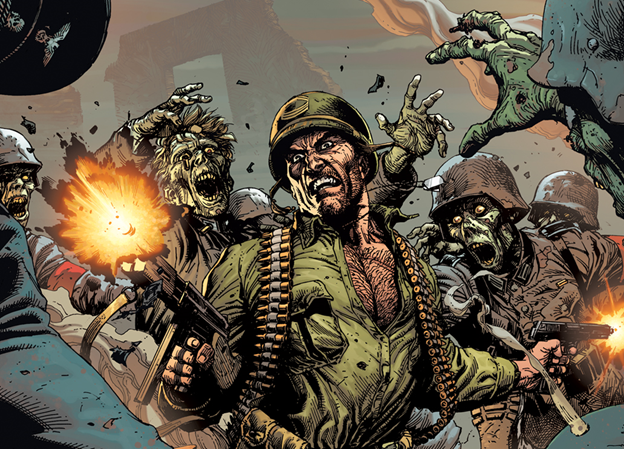
A tragedy as hurtful as the loss of a loved one defined the early life of Sgt. Rock. He was born as Franklin John Rock in Pennsylvania, USA, and grew up without his actual father Sgt. John Michael Rock, who had passed during World War I. His stepfather, John Anderson too met his demise quite early on, and Sgt. Rock’s only option then was to become the primary monetary support to his family.
After graduating from the Hillside High School, he first chose to be a prizefighter, but eventually ended up in the same steel mill that his stepfather used to work in. Rock did think for a while that it was some divine intervention as he met another father figure there, but this individual also passed away, leaving Rock very emotionally vulnerable. His siblings too were victims of early-life crises – accidents, permanent immobility, and death.
Enlistment was probably written in his fate with the onset of World War II. Rock was promoted to ‘Assistant Squad Leader’ when his superiors suddenly passed while he was stationed in North Africa. His position as Sergeant was set in stone when he maintained the position of his unit Easy Company atop a hill, despite being brutally attacked by Germans and losing several men on their side. Post that, he was offered a promotion several times but he chose to remain on the active battlefield instead, loathing war with every fiber of his being but remaining loyal to his team.
The stories of Sgt. Rock’s adventures happen on Earth-One and Earth-Two concurrently. The difference is non-existent or almost so. Sgt. Rock has remained quite significant over the years, appearing alongside Batman, Suicide Squad, and even Superman.
SGT. ROCK: Appearance in Comics
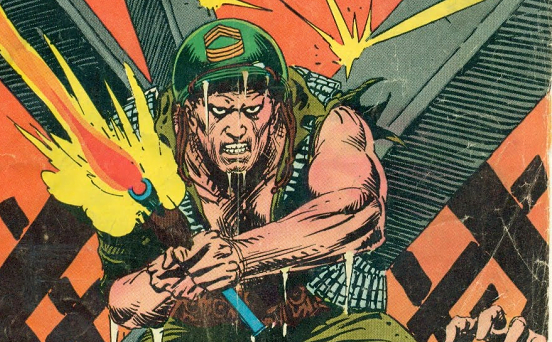
In Issue 83 of the anthology ‘Our Army at War’, we met the most definitive Sgt. Rock. An artist pars any comparison, Joe Kubert gave Sgt. Rock the face and form that we know today. Given that 1958 was a time we had quite an overflow of memorable characters in a genre of comics that was widely read, Sgt. Rock managed to make quite a mark and the art definitely had something to do with it.
The uneven ‘boxer’s nose’, an ever-present stubble, a slightly-angled helmet, and a lot of masculinity wrapped in military uniform – Sgt. Rock had quite the laconic reactions to the most appalling of dangers. Honestly, an honorary cape ought to be put on him for the fact that he was no less a superhero than his red or black-caped counterparts.
More than half a century after these stories were written, they can still become a beautifully detailed topic of discussion for those into it. Rock is well aware that it is entirely on him to bring his troops through Hell in one piece, and the drama of these stories lies in wondering how the mission will play out, and which individual in Sgt.’s team will receive a lesson in the masculine values of warfare.
The act with Sgt. Rock as the narrator is so raw, so very powerful – and sometimes the panels seem to be as good as 4D, with Rock trying to talk to us directly, it seems. Bob Kanigher, the OG creator and storyteller is extremely straight, severe, and battle-worn with readers. He often makes use of panels in a ‘triptych’ style of sorts to get the reader’s attention on focal moments of immense stress – such as an injured Sgt. Rock being brave and bold re-loading his gun, or another soldier dragging a box of ammunition through heavy snow.
Over an 18-month period, DC gave us quite a few stories centered around this man. It is surprising that the longest of its kind was barely some 20 pages or so. But the essence was so good, that it changed Sgt. Rock’s status is from a character in a seemingly disposable, shortly-popular comic series to an icon from the Silver Age of comics, as he is known today. Unlike several other superheroes, the focal point of the character is him being up close and personal with each reader, especially in those times.
Each of the stories of Sgt. Rock and Easy Company is their mission or a part thereof. There is only the unending war – battles after battles (as hopeless as ever), no business on the sidelines – just a raw description of a battlefield with soldiers and no quiet moments or things like letters from home. The perfect word to describe the entire series is ‘robust’, as DC made sure there was a retitle in 1977 and 300+ issues were out to read.
SGT. ROCK: Appearance in ‘Justice League Animated Series’ and ‘Batman – The Brave and the Bold’
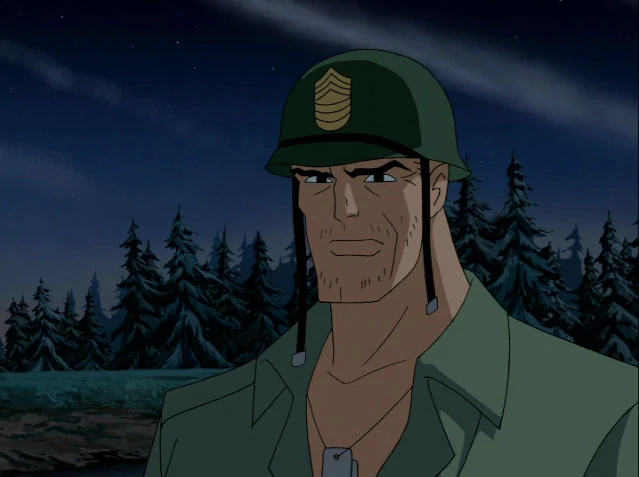
The ‘Justice League Animated Series’ was graced by the appearance of Sgt. Rock in Parts II and III. The facts of him being the commander of the ‘Easy Company’ unit and a sergeant in the U.S. Army in World War II were retained.
In Part II, as Allied Forces were being attacked and wanted to withdraw their men from a certain beach area, Superman, Flash, and Hawkgirl were the only remaining League members trying to help. While the attempt to vacate the area and help the troops was on, Flash realized that Lantern had been left in arrears. He wanted to go back and find Lantern; what he did not know was that Lantern was knocked out from War Wheels, having barely escaped. Lantern remained hidden, unable to answer people calling out for him.
At some point, Lantern gained consciousness and found himself with the Easy Company, recognizing them as American Commandos. He was then told that they were looking for and wanted to destroy the hidden German airfield from which another invasion was being plotted. Initially skeptical because Lantern’s ring was missing, Sgt. Rock saw him throw aside one of their biggest men, Bulldozer like he was nothing. As a reward, Lantern was made a part of the Easy Company, also owing to Lantern’s own U.S. Marine Corps service background.
It is not until Part III that the Easy Company and Lantern found the airfield they were looking for. Located under an artificial hill, they were able to locate it just as the invaders were being given the order to “Go”. Amidst an open fire from Sgt. Rock and his unit, the planes took off rapidly. Lantern rushed ahead and took off on Savage’s flagship with him, while the Justice League was informed of the invasion being en route. Flash took off across the Atlantic Ocean to inform the troops in America while the rest of the League busied themselves in intercepting the planes that had reportedly flown from the German base.
Meanwhile, Lantern managed to make the commanding plane’s system quite dysfunctional. That in turn, cut off radio contact between Savage’s plane and those of the others, and without the leader’s instructions, the rest of them had to slow down considerably. Savage himself was quite a fighter, and he tortured Lantern by holding him captive. The League arrived shortly after, attacking the planes which of course, fired back. A few action-heavy scenes later, it so seemed that Savage had been overpowered as he was last seen drowning in the ocean.
The tale of Sgt. Rock in ‘Batman: The Brave and the Bold’ is slightly different. The war setting remained, with Sgt. Frank Rock enlisting himself to fight on behalf of the U.S. Army right after Pearl Harbor was bombed by Japan in December 1941. His first assignment was to the European Theatre of War. As Private Rock back then, he shone on D-Day in 1944, as the Battle of Three Stripes Hill happened. What he got was a well-deserved battlefield promotion to the rank of Sergeant, and he was to lead the mighty Easy Company as their commander.
It was on D-Day that G.I. Robot and Batman lent a hand to Sgt. Rock. G.I. passed away taking down a concrete bunker that Rock was held under. Sgt. Rock didn’t fail to shed a tear or two before he took off with Easy Company so they could take down the Axis Powers, liberating France in the process.
SGT. ROCK: The DC Showcase
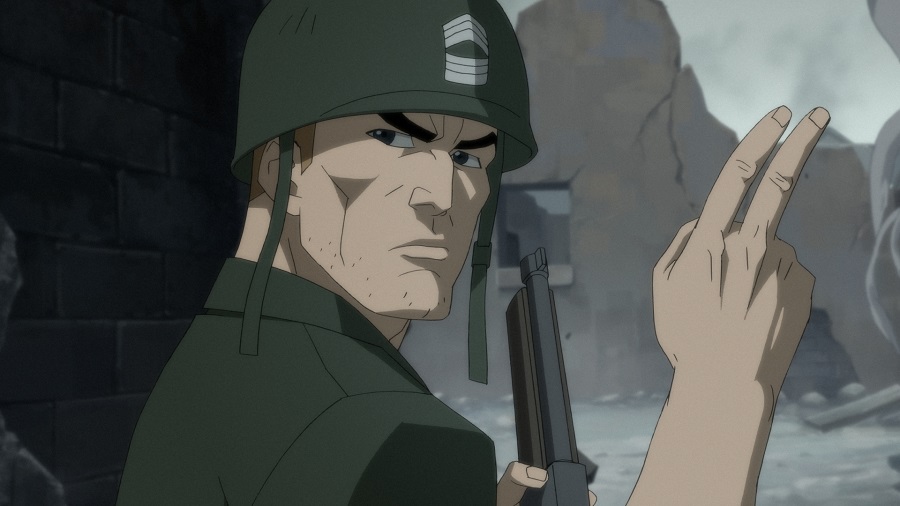
The DC Showcase of Sgt. Rock was ICONIC, to say the least. It was a short war film, laced with the superhero’s enigmatic presence. It was the creation of stalwarts of the industry like Bruce Timm and produced by the Warner Brothers’ house, compelling its inclusion in the home media release of ‘Batman: Hush’.
Having lost his regiment in a violent battle and himself confined to bed recovering from injuries that he had sustained; Sgt. Rock woke up to a lot of harsh realities and physical as well as mental strain. His spirit to fight lived through it all, so Lt. Matthew Shrieve gave Rock the responsibility to forge ahead with another mission. This time, he was to lead the ‘top-secret’ Creature Commandos who would be at his absolute service.
The task entailed capturing alive, a Nazi scientist and his assistant hiding in some medieval castle that the Commandos and Sgt. Rock had to locate. These Commandos were quite the star-studded team, with the presence of Sgt. Vincent Velcoro, a vampire, Pvt. Elliot “Lucky” Taylor, a Frankenstein-like Monster, and Pvt. Warren Griffith, a wolfman hybrid! Velcoro especially, was out for blood (pun intended!) as he had to be physically restrained from attacking the Nazis he saw as food. Quiet and undisclosed entry to the premises was after all of utmost importance.
And they managed to do that, gain entry that is. Here’s where things went slightly downhill as the team was attacked by Rock’s arch-rival, Iron Major. As their fight ensued, the assistant of the Nazi scientist turned on a generator, activating a “rumored doomsday weapon” for ultimate destruction. In what can only be called a horror story unfolding, Lt. Shrieve tried to contact Sgt.
Rock, but Rock missed the message due to a loud noise coming from the laboratory itself. Taylor had managed to ruin the generator right when the steel doors of it burst open. Sgt. Rock saw a hint of U.S. Army uniform and thought he finally had the much-needed reinforcements but unfortunately, it was a situation much worse than that. Iron Major cackled in pure joy as the army of zombies – the old, now dead ‘Easy Company’ squad of Sgt. Rock – threatened to take over the entire team of Commandos.
Five of the zombies had been killed before the Commandos realized that Bulldozer was still being powered through it. If Bulldozer managed to wake, they would be no match against him. That is when Sgt. Rock took charge and reached his Thompson submachine gun, using it to blow off Bulldozer’s head entirely. In the midst of all this, the laboratory caught fire. Sgt. Rock and his commandos ambushed Iron Major and the others trying to escape.
Trying to rile up the Commandos and their leader, Iron Major taunted them by saying that the target of being captured alive was only set for them because the U.S. wished to have their own ‘Army of the Dead’. Determined to not let any of the bad guys remain, Rock ordered the immediate shooting of all enemies they had fought and captured at the lab. Then he made sure to burn down the whole castle so that no traces of any evil research remained at all.
In the setting outside, post-battle, Sgt. Rock addressed his commandos, telling them that he made a huge mistake taking their powers, grit, determination, and feelings for granted. He blamed Lt. Shrieve for it but also pointed out that he wanted to set it all right. He promised he would make every effort so that they would not be exploited for battle in that manner ever again. As they left the scene, Sgt. Rock is shown taking a final look at the burning castle, knowing that his Easy Company got their deserved cremation.
SGT. ROCK: What Makes Him Special?
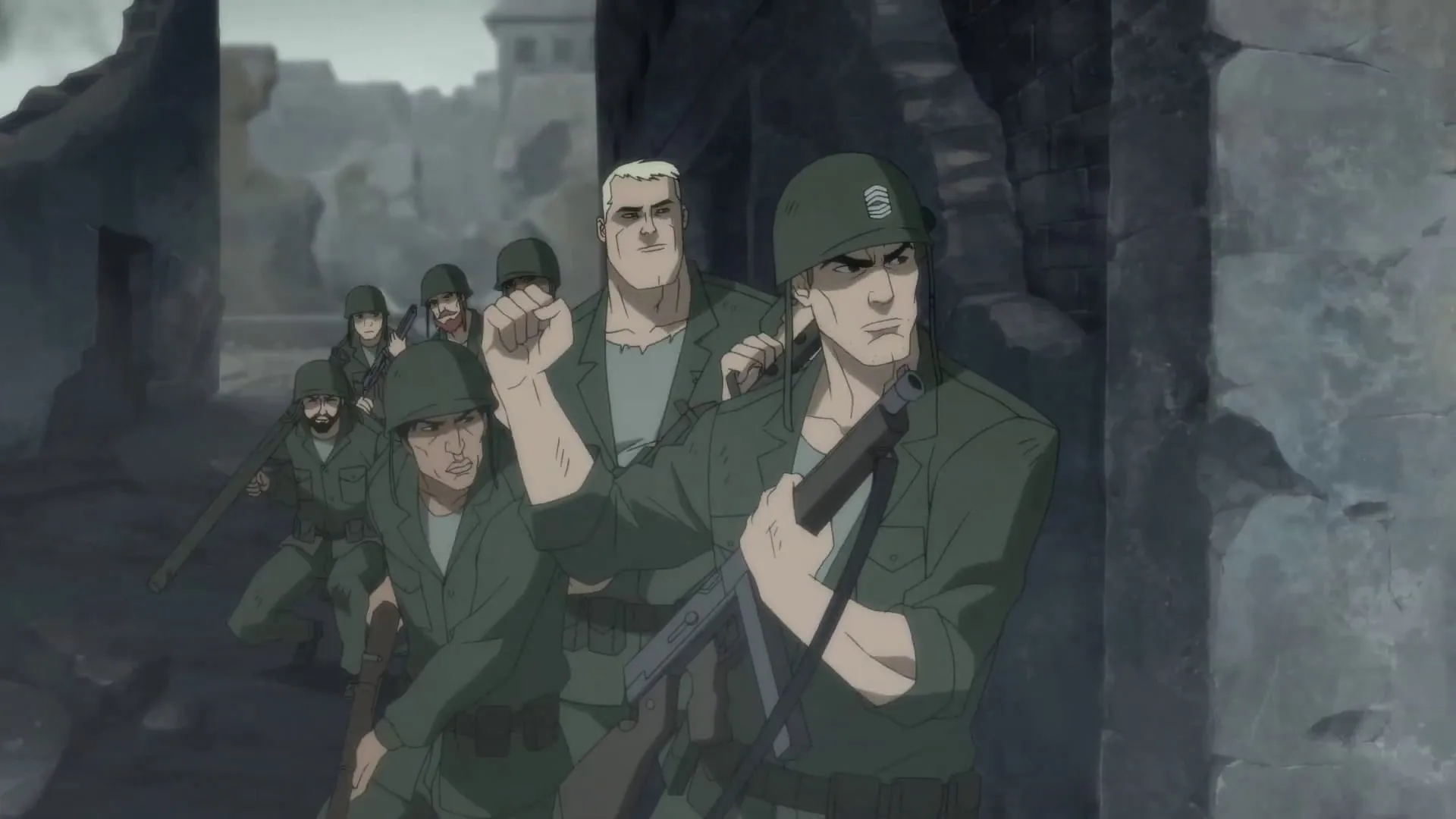
Needless to say, the soldier in Sgt. Rock is quite the sharp-shooter with his beloved .45 Caliber Thompson Submachine Gun, and grenades serving him loyally as he takes down fighter planes one after the other. His hand-to-hand fighting style incorporates some boxing and street-fighting moves, making him a formidable close-combat opponent. His leadership skills lined with resilience and a tactician’s brain are quite a glorious addition to his daunting persona. That is not to say he isn’t compassionate or lacks feelings – war only roughens the edges of a person and it did that to him too. On the inside, Sgt. Rock is all too exposed and raw to doubts, genuinely concerned for his unit of soldiers, and often having reservations about his own leadership abilities.
As a soldier must – he possesses several weapons and ammunition, and he uses them well. 30 Caliber Ammunition Belts alongside an M-1 Garand Cartridge Belt, and a .45 Caliber Colt M1911A1 Automatic Pistol make for a perfect picture – and several perfect panels of comics and scenes in visual media otherwise.
SGT. ROCK: Closing In
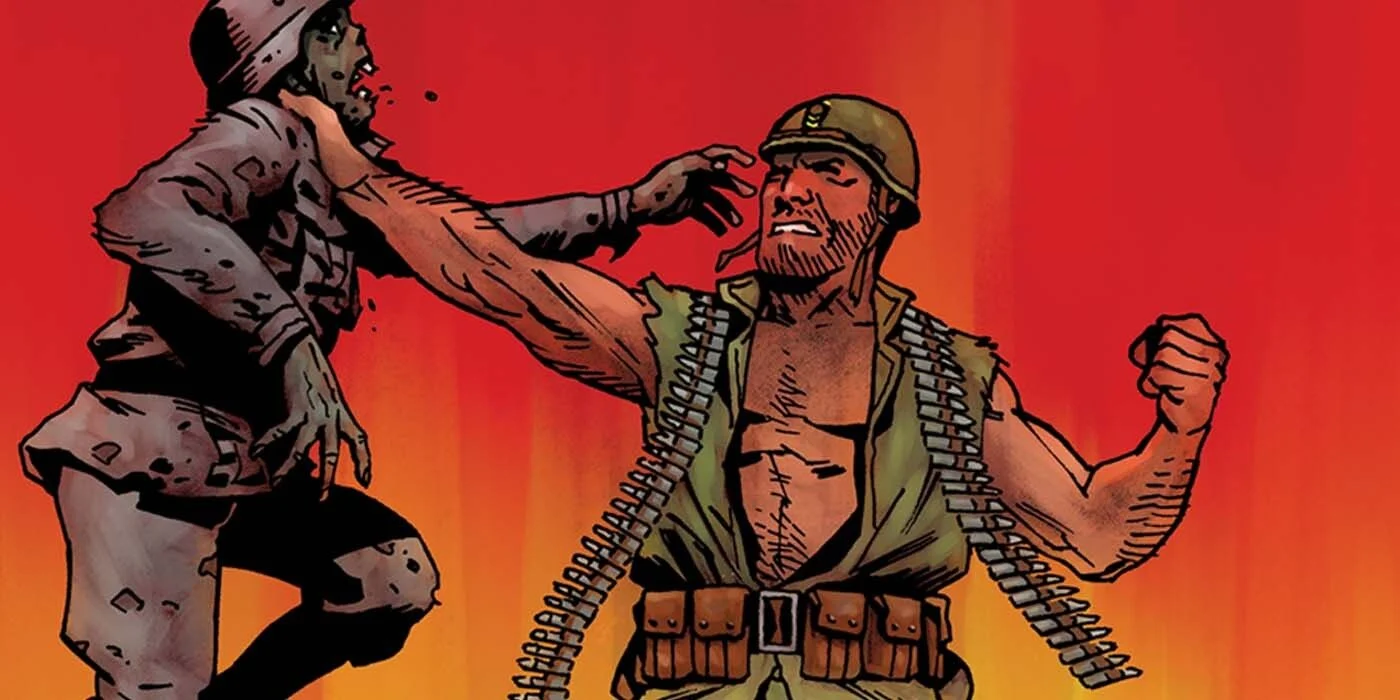
Kanigher went on record to say that sadly enough, Sgt. Rock and Easy Company perished in World War II. Issue 4 of the ‘DC Universe Legacies’ in its backup story almost confirms the largely speculative circumstance of Sgt. Rock’s death – the last bullet of the final battle in World War II claimed the brave soul’s life dedicated to his country. His post-War adventures are cloaked by uncertainty, as Sgt. Rock was found to be only an imposter in Volume 2, Issue 12 of Suicide Squad.
Artist Kubert may have given Sgt. Rock a worn-down look, but the man remained undefeated in spirit and in person. He never wanted war, he never encouraged violence – but like an ideal citizen of the country of America, he did not back down when there was a call for soldiers to defend the nation.
